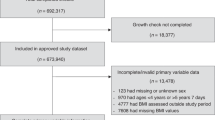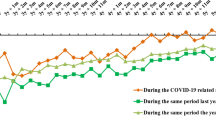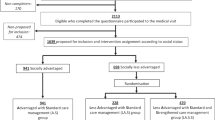Abstract
Aims:
Prevention of obesity is a public health agenda. There are only few longitudinal studies on prevention of overweight in children. The Kiel Obesity Prevention Study (KOPS) intends to characterise the determinants of childhood overweight and the effect of preventive measures within schools as well as within families.
Methods:
Between 1996 and 2005, KOPS investigated 4997 German 5–7 and 4487 9–11-y-old children or 41 and 37% of the total population of all first and fourth graders in 32 primary schools in Kiel (248 000 inhabitants), northwest Germany. Main outcome measures were nutritional status, health habits and risk factors of disease. In addition, health promotion was performed each year in three schools for all first graders and their teachers (nutrition education and active school breaks) together with a family-oriented approach in families with obese and preobese children. Up to now, the children were followed for 4 y and were reinvestigated at age 10 y.
Results:
The KOPS population was representative for all 5–7 and 9–11-y-old children in Kiel. The prevalence of overweight/obesity (≥90th/97th BMI reference percentile) was 7.0/5.8 and 11.3/6.3% in 5–7 and 9–11-y-old children, respectively. Parental overweight, a low socio-economic status and a high birth weight were identified as main risk factors for overweight in prepubertal children. The first results of the interventions show that obesity prevention was possible, but there were limited success rates in boys and children from low social class.
Conclusion:
Faced with the environmental contributors to the obesity problem societal rather than individual responsibilities are evident. This idea suggests that dissecting and tackling the obesogenic environment is necessary to complement school- and family-based interventions.
This is a preview of subscription content, access via your institution
Access options
Subscribe to this journal
Receive 12 print issues and online access
$259.00 per year
only $21.58 per issue
Buy this article
- Purchase on Springer Link
- Instant access to full article PDF
Prices may be subject to local taxes which are calculated during checkout
Similar content being viewed by others
References
WHO. Obesity, preventing and managing a global epidemic. Report of a WHO Consultation. WHO Technical Report Series 894, Geneva; 2000.
Kumanyika S, Jeffery RW, Morabia A, Ritenbaugh C, Antipatis VJ . Obesity prevention: the case for action. Int J Obes Relat Metab Disord 2002; 26: 425–436.
Flodmark CE, Lissau I, Moreno LA, Pietrobelli A, Widhalm K . New insights into the field of children and adolescents' obesity: the European perspective. Int J Obes Relat Metab Disord 2004; 28: 1189–1196.
Guo SS, Roche AF, Cameron Chumlea W, Gardner JD, Siervogel RM . The predictive value of childhood body mass index values for overweight at age 35 y. Am J Clin Nutr 1994; 59: 810–819.
Must A, Jacques PF, Dallal GE, Bajema CJ, Dietz WH . Long-term morbidity and mortality of overweight adolescents. N Engl J Med 1992; 327: 1350–1355.
Whitaker RC, Wright JA, Pepe MS, Seidel KD, Dietz WH . Predicting obesity in young adulthood from childhood and parental obesity. N Engl J Med 1997; 337: 869–873.
Parsons TJ, Power C, Logan S, Summerbell CD . Childhood predictors of adult obesity: a systematic review. Int J Obes Relat Metab Disord 1999; 23 (Suppl. 8): 1–107.
Guo SS, Wu W, Chumlea WC, Roche AF . Predicting overweight and obesity in adulthood from body mass index values in childhood and adolescence. Am J Clin Nutr 2002; 76: 653–658.
Dietz WH . Health consequences of obesity in youth: childhood predictors of adult disease. Pediatrics 1998; 101: 518–525.
Power C, Lake IU, Cole TJ . Measurement and long-term health risks of child and adolescent fatness. Int J Obes Relat Metab Disord 1997; 21: 507–526.
Berenson GS, Srinivasan SR, Bao LN, Newman WP, Tracy RE, Wattigney WA, for the Bogalusa Heart Study. Association between multiple cardiovascular risk factors and atherosclerosis in children and young adults. N Engl J Med 1998; 338: 1650–1656.
Berenson GS, Wattigney WA, Bao W, Srinivasan SR, Radhakrishuamurrthy B . Rationale to study the early natural history of heart disease: The Bogalusa Heart Study. Am J Med Sci 1995; 310 (Suppl 1): 22–28.
Mahoney LT, Burns TL, Stanford W, Thompson BH, Witt ID, Rost CA, Lauer RM . Coronary risk factors measured in childhood and young adults life are associated with coronary artery calcification in young adults: The Muscatine Study. J Am Coll Cardiol 1996; 27: 277–284.
Vanhala M, Vanhala P, Kumpusalo E, Halonon P, Tallala I . Relation between obesity from childhood to adulthood and the metabolic syndrome: population-based study. BMJ 1998; 317: 319–321.
Ebbeling CB, Pawlak DB, Ludwig DS . Childhood obesity: public-health crisis, common sense cure. Lancet 2002; 360: 473–482.
Dietz WH, Gortmaker SL . Preventing obesity in children and adolescents. Annu Rev Public Health 2001; 22: 337–353.
Campbell K, Waters E, O'Meara S, Summmerbell C . Interventions for preventing obesity in childhood. A systematic review. Obes Rev 2001; 2: 149–157 Also published in the Cochrane library (http://www.cochrane.org).
Mueller MJ, Asbeck I, Mast M, Langnaese K, Grund A . Prevention of obesity—more than an intention. Concept and first results of the Kiel Obesity Prevention Study (KOPS). Int J Obes Relat Metab Disord 2001; 25 (Suppl. 1): S66–S74.
Kromeyer-Hauschild K, Wabitsch M, Kunze D, Geller F, Geiß HC, Hesse V, von Hippel A, Jaeger U, Johnson D, Korte W, Menner K, Müller G, Müller MJ, Niemann-Pilatus A, Remer T, Schaefer F, Wittchen H-U, Zabransky S, Zellner K, Ziegler A, Hebebrand J . Perzentile für den Body-mass-Index für das Kindes- und Jugendalter unter Heranziehung verschiedener deutscher Stichproben. Monatsschrift Kinderheilkunde 2001; 149: 807–818.
Reinken L, Stolley H, Droese W, van Oost G . Longitudinale Körperentwicklung gesunder Kinder. II Größe, Gewicht, Hautfalten von Kindern im Alter von 1,5-16 Jahren. Klin Pädiat 1980; 192: 25–33.
Danielzik S, Czerwinski-Mast M, Langnäse K, Dilba B, Müller MJ . Parental overweight, socioeconomic status and high birth weight are the major determinants of overweight and obesity in 5-7-y-old children: baseline data of the Kiel Obesity Prevention Study (KOPS). Int J Obes Relat Metab Disord 2004; 28: 1494–1502.
Körtzinger I . Ernährungserhebung und Ernährungsintervention in der Prävention ernährungsabhängiger Erkrankungen. Dissertationsschrift, Institut für Humanernährung und Lebensmittelkunde der Christian-Albrechts-Universität zu Kiel, Kiel 1999.
Langnäse K, Asbeck I, Mast M, Müller MJ . Influence of socio-economic status on the long-term effect of family-based intervention in prepubertal overweight children. Health Educ 2004; 104: 336–343.
Müller MJ, Danielzik S, Pust S . School- and family-based interventions to prevent overweight in children. Proc Nutr Soc 2005; 64: 249–254.
Barker DJP, Blundell JE, Dietz WH, Epstein LH, Jeffry RW, Remschmidt H, Rolls BJ, Rössner S, Saris WHM . Group report: what are the Bio-behavioral determinants of body weight regulation?. In: Bouchard C, Bray GA (eds). Regulation of body weight Dahlem workshop reports, Life Sciences Research Report 57, Wiley Johnsons: Chichester; 1996. pp 159–177.
Lobstein T, Baur L, Uauy R, IASO. Obesity in children and young people. A crisis in public health. Obes Rev 2004; 5 (Suppl 1): 4–104.
James WPT, Gill TP . Prevention of obesity. In: Bray GA, Bouchard C (eds). Handbook of obesity, clinical applications 2nd edn Marcel Decker: New York; 2004. pp 75–96.
Müller MJ, Danielzik S, Spethmann C . Prevention of overweight and obesity. In Obesity in childhood and adolescence Kiess W, Marcus C, Wabitsch M (eds) Karger: Basel; 2004; 243–263.
Gortmaker SL, Peterson K, Wiecha J, Sobol AM, Dixit S, Fox MK, Laird N . Reducing obesity via school-based interdisciplinary intervention among youth. Planet Health Arch Pediatr Adolesc Med 1999; 153: 409–418.
Wang LV, Yang Q, Lowry R, Wechsler H . Economic analysis of a school-based obesity prevention program. Obes Res 2003; 11: 1313–1324.
Epstein L, Valoski A, Wing RR, McCurley J . Ten-year follow-up of behavioral family-based treatment of obese children. JAMA 1990; 264: 2519–2523.
Epstein LH, Valoski A, Wing RR, Mc Curley I . Ten year outcomes of behavioral family-based treatment for childhood obesity. Health Psychol 1994; 13: 373–383.
Flodmark CE, Ohlsson T, Ryden O, Sveger T . Prevention of progression to severe obesity in a group of obese Schoolchildren treated with family therapy. Pediatrics 1993; 91: 880–884.
Egger G, Swinburn B . ‘An ecological’ approach to the obesity pandemic. Br Med J 1997; 315: 477–480.
Egger G, Swinburn B, Rossner S . Dusting off the epidemiological triad: could it work with obesity? Obes Rev 2003; 4: 115–119.
Acknowledgements
This work was supported by grants from Deutsche Forschungsgemeinschaft (DFG Mü 5-1, 5-2, 5-3, 5-5), Wirtschaftliche Vereinigung Zucker, Precon and WCRF UK.
Author information
Authors and Affiliations
Corresponding author
Rights and permissions
About this article
Cite this article
Danielzik, S., Pust, S., Landsberg, B. et al. First lessons from the Kiel Obesity Prevention Study (KOPS). Int J Obes 29 (Suppl 2), S78–S83 (2005). https://doi.org/10.1038/sj.ijo.0803099
Published:
Issue Date:
DOI: https://doi.org/10.1038/sj.ijo.0803099
Keywords
This article is cited by
-
Impact of a one-year school-based teacher-implemented nutrition and physical activity intervention: main findings and future recommendations
BMC Public Health (2020)
-
Long-term effects of adolescent obesity: time to act
Nature Reviews Endocrinology (2018)
-
Adiposity rebound is misclassified by BMI rebound
European Journal of Clinical Nutrition (2013)
-
Physical activity, nutrition, screen time and sleep associated with body weight and physical condition in young children
Sportwissenschaft (2013)
-
Different age-specific incidence and remission rates in pre-school and primary school suggest need for targeted obesity prevention in childhood
International Journal of Obesity (2012)



